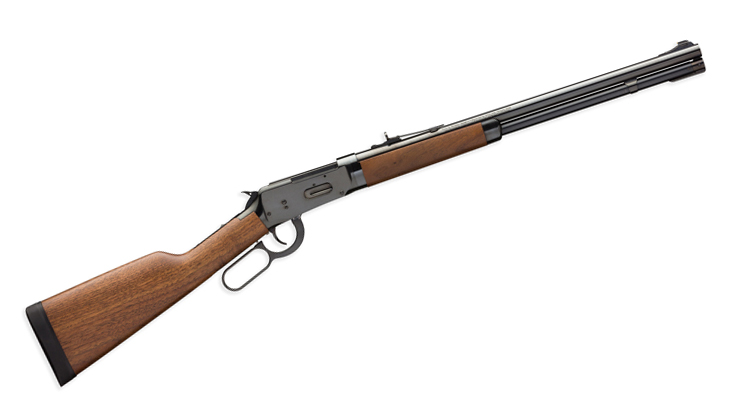
One thing you can say about gunners: They are an opinionated lot. And their opinions can be fervently zealous. Take, for example, the Winchester Model 94. Aficionados of John Browning’s lever-action cite its reliability, light weight and handiness. There’s no doubt about it, the Model 94 is one of the easiest rifles to pack around day in and day out. Detractors snivel that its cartridge—primarily the .30-30 Win., but there are others—is hopelessly weak and out of date. Well, there may have been a small point to the latter’s claim, although it was once chambered for the black powder cartridges .32-40 Winchester and .38-55 Winchester, which to some extent made the transition into the smokeless powder era. But that is no longer the case. Winchester has brought out its iconic lever-action rifle in a new chambering with plenty of thump—the .450 Marlin.
This new version is labeled the Model 94 TE (for Trails End), and it is a takedown rifle. Takedown rifles are often touted for being handy and easy to transport, although I do not ever recall anyone disassembling a rifle to travel with it. However, the capability of cleaning the rifle from its breech is an excellent characteristic for those who want to maintain the best inherent accuracy the rifle has. To takedown the rifle, simply fold out the magazine lever at the front and unscrew it about a half inch or so; unlock the bolt from the breech of the barrel by lowering the main lever a bit and give the barrel/magazine assembly a quarter-turn clockwise. Reassemble it in reverse order. It’s that easy.
Other than the barrel having five ports set 90 degrees apart at the muzzle and the Pachmayr Decelarator recoil pad, this latest iteration of the classic ’94 hasn’t changed all that much—though it still has the ridiculous hammer-block, tang safety. During my testing, I inadvertently slipped the safety on a couple of times, resulting in a disappointing “click” when I wanted the rifle to fire. The ports and the Decelerator pad do take some of the back-end sting out of the rifle. Another small departure from the traditional ’94 is the bolt trunions have been rounded slightly, making the cycling of the rifle a little slicker.
The newer ’94s all feature the Angle-Eject bolt, allowing for a scope to be mounted over the action, consequently the rifle is drilled and tapped for those who prefer optical sights. But it wouldn’t be a ’94 without the brass-bead front and buckhorn rear sights. During my testing I took advantage of the adjusting capability of the rear sight, drifting it with a brass punch and lowering it with the elevator.


A friend has asked me why the .450 Marlin chambering? It’s a good question. The reasoning was that in order to get .45-70 performance in the ’94 platform, Winchester had the choice of making a larger receiver to accommodate the .608"-diameter rim of the .45-70—a much more costly investment—or go with a cartridge that performs like the .45-70 but does so in a smaller, more efficient package. Hence the .450 Marlin. The cartridge, introduced in 2000 by Marlin for its own lever-action Model 1895M, was designed to provide +P performance of the 144-year-old government round in a more modern case capable of handling those pressures. It drew some interest but not enough to keep Marlin chambering its rifle in it. Browning still chambers its BLR in .450 Marlin, but this is the first time Winchester has delved into this caliber. The .450 Marlin’s parent case is the .458 x 2 wildcat cartridge. Marlin and Hornady—who was a partner in the development and is the only ammo manufacturer to load the round now—made the belt on the upstart a bit longer to prevent anyone chambering it in a belted magnum rifle other that the .450 Marlin. Hornady offers but one loading in .450 Marlin, a 325-gr. FTX bullet at 2077 fps across my Oheler 35P chronograph. It’s a fine deer, elk, moose or bear cartridge out to 200 yards. Handloaders could have a ball with the variety of bullet weights in this caliber, but be aware that the heaviest bullets, say more than 405 grains, will require deeper seating in the case in order to function in this rifle, and that can be a detriment to getting the most ballistic performance.
Loading this ’94 shows exactly why the .450 Marlin chambering was chosen over the traditional .45-70. The .528" rim of the Marlin cartridge just barely clears the loading port. The magazine holds six rounds, and like most lever-actions with tubular magazines, you’ll need to usher that sixth round a bit forward with your pinky in order to clear the loading gate.
At the range it was almost like shaking hands with an old friend. There’s just nothing like cycling a ’94. The trigger was a bit stiffer than I like at 6 lbs., 5 oz., but it was crisp and a lot better than some of the latter American-made ’94s. Recoil was there, all right, but not abusive, especially given its 6 3/4 lbs. weight. The rifle was surprisingly accurate yielding an average of 2.88" at 100 yards off sandbags. I have some video of me shooting it, and the muzzle only slightly moved off the rest, most of the movement was rearward, indicating that the ports on the barrel did their job.
While it may not be a half-mile deer and antelope slayer, there is no denying that the Model 94 retains its legendary handiness. Combine that with the .450 Marlin chambering that provides nearly 60 percent more energy than the .30-30 Win., and you have a serious backwoods rifle. I really like the takedown feature for the ease of cleaning it provides. With an MSRP of $1,459 and an approximate street price of $1,190. The Model 94 TE is also chambered in the ubiquitous .30-30 Win. I, for one, am glad to see it back.
Manufacturer: Winchester
Model: Model 94 TE
Type: Lever-action repeating rifle
Caliber: .30-30 Win., .450 Marlin (tested)
Barrel Length: 20 “
Magazine/Capacity: Tubular/6 rounds
Trigger: 6 lbs., 5 oz.
Twist: 1:20” RH
Sights: Buckhorn rear, brass bead front
Safety: Tang-mounted hammer block
Stock: Walnut, satin finish
Drop at comb/heel: 1 1/4/1 3/4 inches
Overall Length: 38“
Weight: 6 lbs., 12oz.
Metal Finish: Brush polished blue
MSRP: $1,459





































